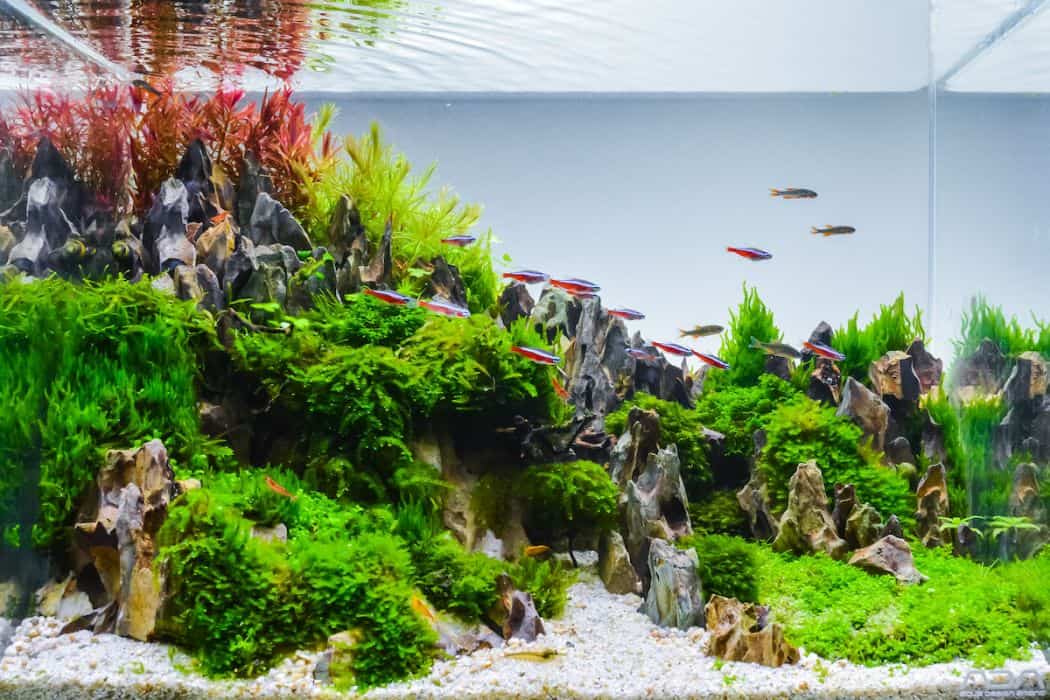Whether you are already a fish fanatic or a newbie to the delights of the underwater world of aquaria, aquascaping could be that special hobby that becomes an all-consuming passion.
We invite you to dip your toe into this intriguing pastime that seamlessly blends, aquarium keeping with landscaping, ecology, and even high art!
Our complete guide to aquascaping should equip you with everything you need to know to create these ethereal and otherworldly underwater settings and maintain them too.
We have rounded up:
- Essential aquascaping gear for the beginner aquascaper.
- The best substrates, plants, rocks, and other accessories to work with.
Also, this aquascaping hobby guide delivers a useful round-up of online and offline resources to get your new aquatic hobby off to a great start!
The word “Aquascaping” may bring to mind anything from keeping a few pet fish to a clandestine snorkeling activity but is a fast-growing and incredibly addictive hobby that has been embraced by aquarists of all abilities around the world. British botanist James Wong found his Twitter account overwhelmed with over 160,000 likes and many more questions and comments after posting images of one of his aquascapes online.
What is Aquascaping?
Aquascaping is a form of scaled underwater gardening, involving filling an aquarium tank with living plants, which are cultivated to create a natural or dramatic scene. This emerging craft also uses stones, wood, and other objects to enhance the underwater garden effect.
Aquascaping is not only about aesthetics; these carefully crafted aquatic environments are self-contained ecosystems with their unique turnover of nutrients.
Depending on the complexity of your design, maintaining the optimal conditions for your aquascape can get pretty labor-intensive and require lots of equipment and water changes.
Do you need to keep fish for aquascaping?
Aquascaping does not require fish. Including fish in the aquascapes you create is entirely optional and many aquascapers forgo them altogether.
Gardening in a Tank: The Intriguing History of Aquascaping
The emergence of aquascaping as a distinct pastime separate from fishkeeping, is thought to have taken place in the 1970s. Aquascaping draws on centuries of knowledge, innovation, and aesthetics in fishkeeping, particularly of the Romans, Chinese, and Japanese.
The development of the aquarium tank led to the widespread uptake of fish keeping in the 19th century. At the same time, Victorian scientists like the chemist Robert Warington were using tanks and terrariums to demonstrate the oxygen-carbon dioxide cycle, creating self-sustaining ecosystems with aquatic plants and fish.
In the 1950s, all-glass tanks were invented, and seasoned aquarists became increasingly discerning about how an aquarium tank would be dressed, considering not only the inclusion of natural and even native plant and fish species but also the aesthetics, often by using rockwork to add dimension.
Canny carbon dioxide fertilization techniques using soda siphons were also being experimented with and expanded the scope of underwater cultivation as a large quantity of aquatic plant material could be sustained underwater.
Takashi Amano, renowned Japanese cyclist, nature photographer and aquarist, is credited with being the father of aquascaping.
His highly distinctive otherworldly aquarium scenes drew from Japanese gardening techniques and aesthetics such as Bonsai and Zen.
Amano’s use of lush, vivid greenery, driftwood, and rock formations gave the impression of dramatic forested landscapes that had been submerged and have admirers all over the world to the present day.
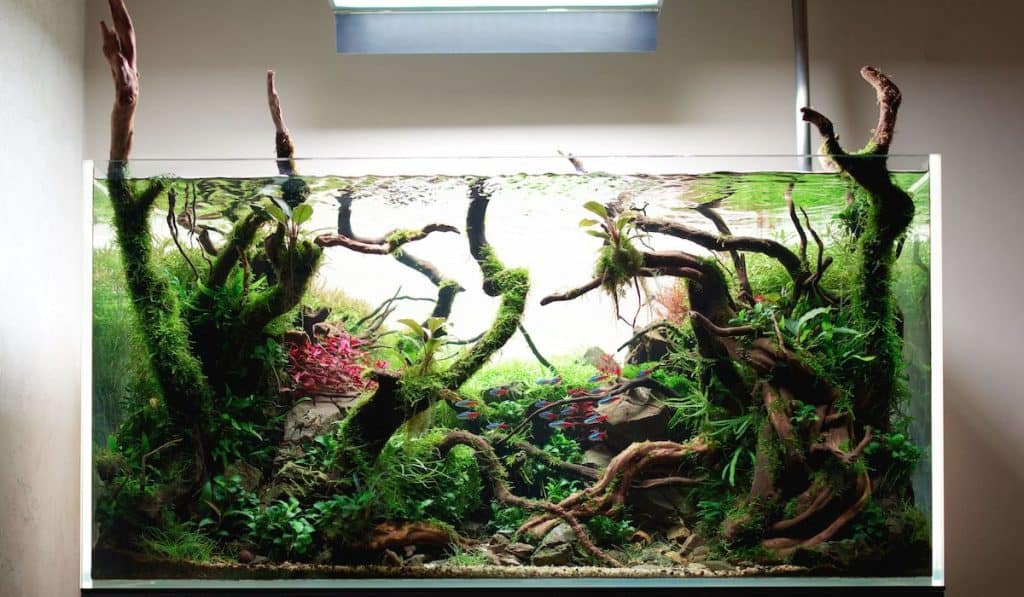
5 Neat Reasons why Aquascaping is a Hobby for You!
- An aquascaping hobby means that you can garden all year round!
If you love cultivating plants, you will know that once the soil starts to cool after the summer sun, the opportunities for gardening quickly diminish.
With aquascaping, you are working indoors and can plant and prune your submerged garden all year round. If you don’t have a backyard or space is limited, aquaculture means you can get your green thumbs wet too!
- If you pay attention to detail, you will enjoy passing time grooming your aquascape.
As we explore further on, aquascaping designs need lots of grooming. Paying attention to the little details can make all the difference in making your design look its best.
This is particularly true of Japanese aquascaping which seeks to imitate natural dryland landscapes. Some plants grow rapidly and require constant trimming and shaping to get the results you’re looking for. If you are keeping fish as well, their nibbling will keep you on your toes.
- You might already be an aquarist; acquascaping can add a new dimension to your hobby.
Many aquascapers have been keeping fish before making the transition to aquascaping.
This is advantageous as you will have the intimate knowledge of water chemistry that is needed to keep an aquascape alive. Cultivating an aquascape may also mean that you can create the perfect jungle style aquascaping environment for particular fish species.
- Hobby aquascaping is a great way of expressing your creativity!
As you research and curate ideas for creating your aquascape, we are sure you will be blown away by how visually stunning these underwater landscapes look.
Aquascaping is a hobby where you can let your imagination run wild. It’s all about taking your ideas and working out how to bring them to life with the substrates, rocks, and plants you have to hand.
- If you love science, you’ll love creating your own ecosystem with your new hobby.
Families will appreciate the excellent learning opportunities that come with creating a thriving ecosystem. As we explore further on, a goal of aquascaping is to create a system that turns over its nutrients and does not become unbalanced leading to a die-off.
Become a master of nitrogen balance and learn about the effects of light and other factors in maintaining your cultivated tank. If you are tech-minded, you can also integrate automated elements including lighting and thermostats for precision control of your carefully crafted environment.
Key Aquascaping Styles and Techniques to Include in Your Hobby
Dutch-style
This famous style of aquascaping brings to mind lush fields with densely planted vegetation with a variety of rich colors and textures.
Dutch-style is the earliest recognized form of aquascaping and started in the 1930s as the range of exotic aquatic plants began to expand.
The Dutch Society of Aquarists is credited with this form of aquarium design that puts more emphasis on the plants than the fish.
You will be able to recognize Dutch style aquascaping by its absence of wood and rock, known as hardscape.
Japanese style
Japanese style or “Nature Aquarium” style aquascaping was championed by the aquarist Takashi Amano, mentioned above. His fascination with the natural world and encyclopedic knowledge of aquatics lives on in this distinctive style of aquascaping.
The objective of Japanese style aquascaping is always to create a miniaturized terrestrial landscape underwater.
Nature Aquarium style draws heavily from Japanese gardening techniques with meticulous attention to the positioning of rockwork and the introduction of a select few plant species that are cultivated to give the impression of a natural landscape.
These aquatic scenes also draw on the Japanese principle of “Wabi-sabi”, which embraces and includes the imperfections and asymmetry encountered in nature in the tank design.
Wabi-kusa
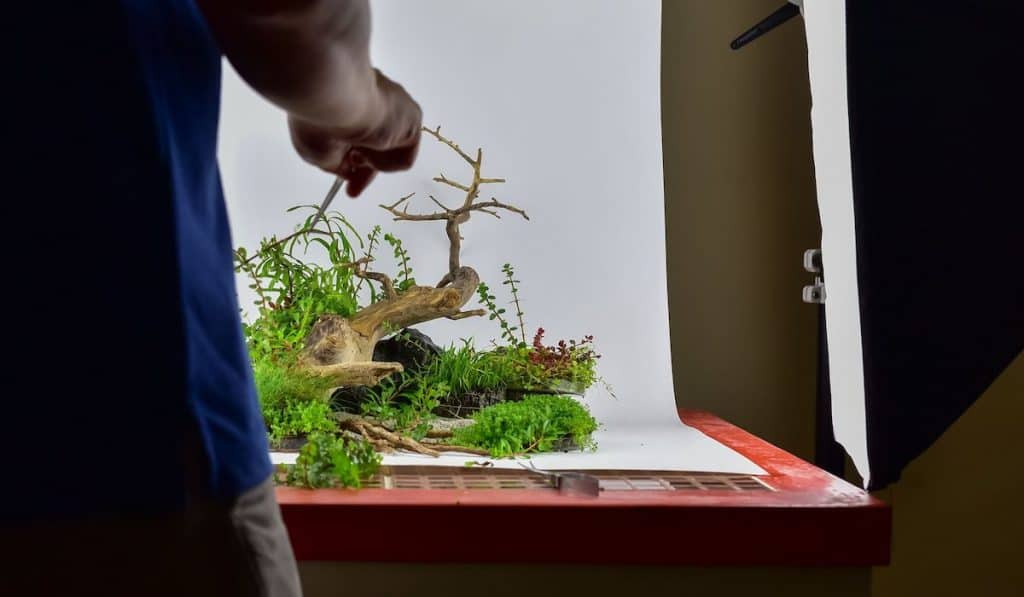
Wabi-kusa is a Japanese gardening technique for aquatic plants that takes balls of plant substrate or aquatic moss and wraps the roots of selected aquatic plants around them, to create modular plantings that can be arranged very flexibly as part of aquascaping designs.
Diorama style
The Diorama style is a fantasy-rich and highly imaginative style of aquascaping that seeks to create a vivid terrestrial scene complete with “grass” covered hills, “trees” and resident fish flying by as birds”.
These storybook tank scenes are very popular with Southeast Asian aquarists who often outdo one another with dramatic, yet meticulously groomed designs.
Jungle style
Wild jungle style is another vegetation-rich style of aquascaping and uses elements of both Dutch and Nature-style aquaria.
This style of aquascaping is all about imitating nature, with tanks taking on the dark, brooding atmosphere of a tropical rainforest. Jungle style tanks are very densely planted, often with large untrimmed leaves.
To create this effect coarse-leaved and tall plants are planted in a dark substrate and allowed to grow wild and tall.
Biotope style.
This mindful form of aquascaping is an attempt to recreate natural aquatic habitats like freshwater pools or mountain streams complete with the hardscape, plants, and fish that complement that environment.
The objective is to emulate and support an existing ecosystem with organisms that naturally coexist.
Even water chemistry and turbidity may be precisely matched, for example, by using leaf litter to stain the water brown.
Saltwater reef aquascaping
Most aquascaping is done in a freshwater tank, but reef aquascaping takes basic aquascaping principles and puts them to work in a saltwater environment.
Here the aim is to mimic a reef, with all the organisms found there, including corals and live rock.
Reef aquarists and aquascapers are adept at creating a thriving environment, stocked with carefully selected species that will not predate one another.
Key Equipment and Accessories for the Beginner Aquascaper
Having the right resources and equipment for aquascaping to hand will make all the difference in the results you experience. Aquascaping requires commitment so there is no better reason to invest in good quality aquascaping tools to develop real expertise in your new hobby.
We hope you will find that this list gives you a good idea of what’s needed for aquascaping.
1. Tank
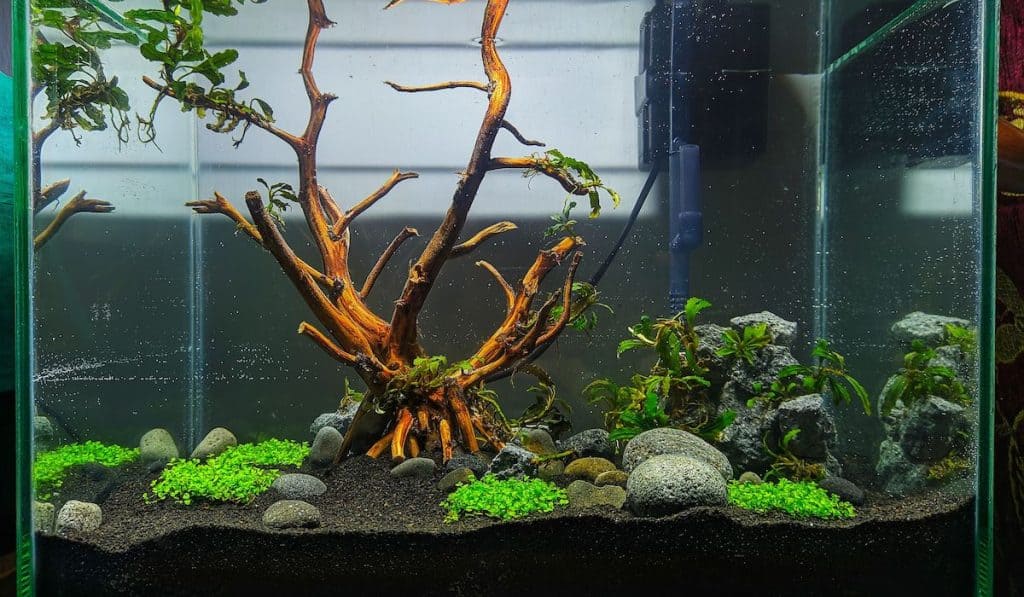
A tank is to an aquascaper what a canvas is to an artist! You can use any type, shape, or dimension of an aquarium tank to create an aquascape.
When choosing your first aquascaping tank you may find that lots of backward depth will provide you with the room that you need to compose your aquascape.
Longer tanks also provide the ideal dimensions for a landscape design and less height on your tank will make lighting easier.
Smaller, more compact tanks also make aquascaping possible if your available space is limited.
Here are some great starter tanks for aquascaping:
- Traditional tank: Tanks can be expensive, especially if they are large. A basic all-glass 10-gallon aquarium tank with or without a lid or hood is an affordable starter tank for your first experimental projects.
- Rimless tank: These stylish tanks are probably what first comes to mind when you think of aquascape design. Rimless tanks like the 25-gallon, rimless low iron aquarium tank from STRELLALAB are made from highly engineered low iron glass that has superior clarity and strength, despite not having the bracing of traditional tanks.
- Nano tank: The nano tank is another stylish tank design albeit on a far smaller scale than most rimless designs. A great example is this 16.9-gallon saltwater Nano tank by Landen . They are either for smaller freshwater or saltwater species. Nano tanks appear to be convenient but aquarists and aquascapers who are not very experienced may find them difficult to maintain.
- Shallow tank: This tank type is becoming increasingly popular as the low height provides unrivaled accessibility. Hobbyist aquascapers enjoy experimenting with hardscape and plants that are not fully submerged. For many aquatic plant species, this means that the plants are actively encouraged to grow above the surface which often induces flowering.
2. Filters
Without a filter to remove, waste, dead foliage, leftover food, and other debris, a tank can quickly become overwhelmed. Filters are generally rated by the size of the aquarium they support. Your choice of filters for aquascaping include:
- Undergravel filters: UG filters like this unit by Lee’s sit beneath the gravel or substrate of the tank, meaning that they are very discrete.
- Canister filters: These canister-like filters are convenient submersible units that are easy to set up in a corner of your tank. The XpertMatic DB368F filter has 3-stage filtration and ultra-quiet functioning that is ideal for the home.
3. Heaters
Thermostatic temperature control is critical to keep a biotope or aquascape thriving. Select a heater that is rated for the water volume of your tank.
Hygger is a reputable aquarium brand that produces a line of digital freshwater aquarium heaters that use quartz-glass to safely maintain your tank’s water temperature.
Simple controls and a clear LCD make all the difference in maintaining a stable temperature. Just attach the heating rod to the wall of your tank to get started.
4. Carbon dioxide system
With so much planted vegetation in your tank, you are likely to need a source of water carbonization to support your living design. CO2 generation systems like this one by FZONE can provide a regulated supply of gas to your aquarium continuously.
5. Lighting
Your strategy for lighting the tank will have a significant effect on aquarium conditions. Excess lighting can lead to the proliferation of algae which can quickly outcompete other tank vegetation and organisms. Lighting, therefore, needs to be able to be as carefully controlled as temperature.
The Hygger digital LED lighting system offers the precision control needed for lighting aquascapes. Its built-in digital timer can be programmed to create 24-hour lighting cycles that mimic the sunrise and sunset and light intensity can be varied across the spectrum. It is easily installed across the top of a tank via adjustable mounting legs.
6. A set of aquascaping tools
Aquascaping tools are needed to cultivate and groom your aquascape. They are sized according to the size (especially depth) of the tank. At a minimum you will need:
- Straight and curved tweezers are used for accessing hard to reach places in the aquascape, like in between rocks and corners of the tank.
- Curved scissors are used to trim stemmed plants and matted vegetation.
- Sand flatteners and algae scrapers have a wedge-shaped blade that can be used to shape substrates and sand and also scrape detritus and algae from tank walls.
- Injectors are used to deliver fertilizes deep within the substrate beneath aquarium plants to prevent the water from becoming overloaded with them.
All the tools can be acquired online. Read this awesome review of the best aquascaping tools by fishkeeping forever.
7. Books
Feed your creativity and knowledge with a decent collection of books on aquascaping. Here are must-have books for the novice aquascaper who is looking to grow:
- Nature Aquarium World by Takashi Amano . This beautiful hardback volume is required reading for every aquarist and aquascaper. Alongside images of the world’s most famous aquascapes, Amano has diligently provided everything you need to know to recreate the designs at home.
- Aquarium Plants (Mini Encyclopedia Series) by Peter Hiscock . Good working knowledge of aquatic plants will help you create viable aquascapes that have the right conditions to thrive. This compact handbook covers over 250 of the most commonly encountered aquatic plants.
8. A Journal
A scrapbook or journal is great for jotting down notes, sketching aquascapes, and curating images and ideas.
A notebook with dotted or graph paper like this smart notebook by The Minimalism Art Store can help you accurately plan your next aquascape.
9. A Camera
You will need a camera on hand to capture all the hard work you will have put into your hobby aquascaping designs. A decent camera for photographing aquarium tanks is also great for visits to Aquatics stores or aquascaping trade shows and contests.
The Nikon D3200 is a basic DSLR that can take great aquarium shots. It has four shooting modes and with adequate lighting and the flash off, a beginner aquarium photographer can capture high-resolution images.
Composing your First Aquascape
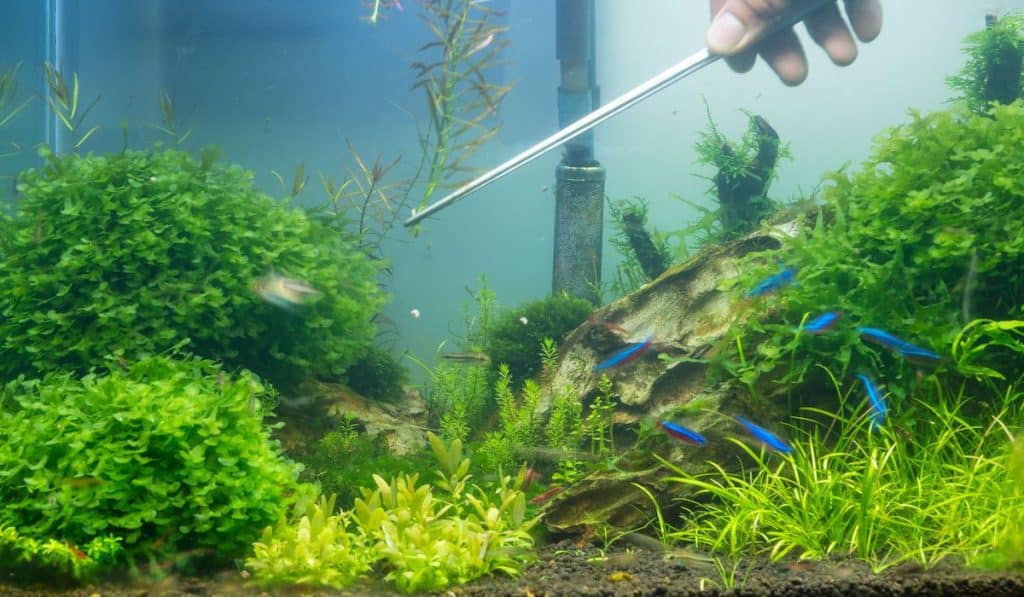
When confronted with some of the fantastic designs created by aquascapers like Filipe Oliveira or George Farmer, getting started might be daunting.
Start simply and add greater detail and complexity to your projects as you gain the experience and skills. Aquascaping is all about aesthetics so you will want to balance the proportions of planted and open space as well as the use of height.
Like landscape painting, aquascaping uses several rules and ratios to help give designers a gauge of the type of composition that will work.
The rule of thirds can be used to plan designs by dividing the tank space horizontally and vertically into thirds. By using this method, you can plan the foreground, midground, and background, and also subtly center your design on a focal point where you will want the viewer’s attention and thoughts to rest as they view your creation.
It can be easy to overcrowd a tank with many plants, but while it is good to embrace variety, establish aquatic plants in stages to see how they become established as part of your design. Also, don’t be afraid to scrap a failing project and start again – experimentation is key. Try, try and try again!
To get an idea of the principles of aquascaping, watch this excellent masterclass by George Farmer:
Materials and Plants for Aquascaping Design
- Substrates, soils, and gravel form the base of design and provide support for the roots of your aquatic plants. They usually provide little nutrition of their own but can operate as a vehicle for delivering a supplementary fertilizer to your vegetation. Aquascapers tend to use natural-colored, dark substrates like this nutrient-rich gravel by Nature’s Ocean .
- Hardscape options include driftwood and natural rock and are used to add structure and perspective to an aquascaping design. These are usually introduced after the substrate and may be placed as a mid-ground feature. Plants can be introduced into the crevices of rocks or encouraged to partially cover them.
- Plants can then be planted in a targeted manner often plunging them by the roots into substate or rock crevices with tweezers. Exercise your flair and creativity by experimenting with leaf size, texture, and of course, color. Aquascapers usually divide aquatic plants into three groups:
- Low-growing plants are usually used in the foreground of an aquascape.
- Mid-growing plants can be used to surround the focal point of your design and can be planted further back to give a sense of height.
- Taller plants are usually added last towards the back and periphery of the aquascape. They are often fast-growing and will require regular trimming to prevent them from reaching the surface and spreading across your tank.
Further reading, links, and resources for the beginner aquascaper
- The Official Aquascaping Reddit is well worth bookmarking. You will find lots of aquascaping inspiration, advice, and Redditors who will be happy to answer all your questions.
- AQUAPROS is one of the best YouTube channels for aquascaping with tutorials, tips, and product reviews.
- The Aquatic Gardeners Association is a thriving global organization with a membership that spans hobbyists of all levels to professional aquarists. They have a packed calendar of events including contests and aquatic plant nursery tours.
- The UK Aquatic Plants Society is one of the world’s foremost forums for aquascaping with many leading aquascapers as founding members.
- Aqua Design Amano is the aquatics company founded by Takashi Amano and has many of the world’s best aquatics products as well as excellent resources and information on its founder.
Rounding Up
Aquascaping is a great hobby that produces some really satisfying and beautiful workmanship in a serene and timeless underwater setting.
For most enthusiasts mastering this aquatic hobby is as much about the exercise of the natural sciences as it is about design.
You will have to accept making some mistakes and even crashing your tank with nitrogen overload if you take your eye off the ball. Water changes are essential for keeping tank conditions optimized, especially if fish are included.
So all you need to do now is grab your first tank and some supplies and have a go. As with most hobbies, practice makes perfect!

